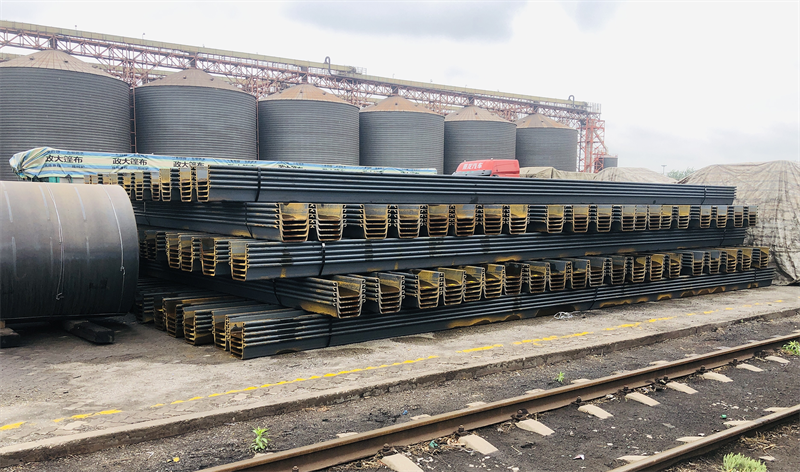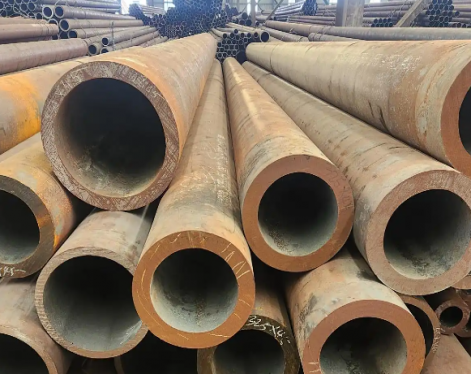Steel sheet pile is a kind of section steel with lock. Its section has straight plate shape, groove shape and Z shape, etc., and there are various sizes and interlocking forms. The common ones are Larson type, Lackawanna type and so on. Its advantages are: high strength, easy to drive into hard soil; it can be constructed in deep water, and if necessary, it can be added with oblique supports to form a cage. Good waterproof performance; cofferdams of various shapes can be formed according to needs, and can be reused many times, so it has a wide range of uses.
There are mainly four typical sheet pile driving methods, and the piling method is selected according to the needs of the construction site and the soil conditions.
1. Root-by-root entry method
This method is to drive steel sheet piles into the soil one by one, which is a simple and convenient piling method. However, in the process of piling, the sheet pile will be inclined, which is suitable for the situation where the soil quality is relatively soft and the length of the sheet pile is relatively small. For dense sandy soil and highly cohesive soil or when there may be obstacles, it is recommended to use the screen driving method.
Advantages: convenient, fast, no need for auxiliary brackets.
Disadvantages: The pile body is easy to tilt during the setting process, and it is not easy to correct after the error accumulates.
2. Screen entry method
Insert the sheet piles into the guide frame in rows in a screen-like manner. This method can ensure good verticality of sheet piles, reduce difficulties and loose piles encountered in the process of piling, and can also better control the length of pile walls. Since the entire row of piles is positioned at the same time, not all piles may be driven to the designed position. If obstacles cannot be driven in, individual piles can be left alone without affecting the overall efficiency.
The screen-type jump driving method can eliminate or minimize the problem of pile inclination. The steel sheet piles are inserted into the soil in rows to a certain depth to form a screen, and these screen-shaped sheet piles are used as a whole to work. This is achieved by following a defined piling sequence, with the number of sheet piles depending on the condition of the soil. Generally speaking, the greater the difficulty of piling, the smaller the number of piles. For example, the length of 2 meters is used for easy-to-hit soil, and the length of 1 meter or less is used for denser soil.
Screen piling can use previously worked sheet piles as guides, which reduces the possibility of the pile being squeezed out of the lock. At the same time, during the piling process, it is necessary to pay attention to the verticality of the sheet pile. Once the inclination is found, relevant corrective measures must be taken immediately.

3. Jump-type entry method
Under harsh geological conditions, it is recommended to use the screen driving method and jump driving method in combination, install the corresponding sheet piles between the guide frames, and then drive the piles according to the following steps:Drill No. 1, No. 3 and No. 5 piles first, and then drill No. 2 and No. 4 piles. If the soil is very dense sand or rock, the pile tips of No. 1, No. 3 and No. 5 piles can be reinforced. In this case, these tip-reinforced piles are always driven first, followed by the other piles No. 2 and No. 4.
4. Driving into the combined pile wall
The composite wall is a pile wall composed of main piles and steel sheet piles in the middle. The main piles mainly include pipe piles, box piles, load-bearing piles and other forms of fabricated piles.
Composite piles must provide a stable, heavy duty, sufficiently rigid guide frame suitable for the length and weight of the pile.
The main pile is positioned on the guide frame with welded guide plate brackets, which take into account the width deviation.
The driving sequence of the main pile must ensure that the entire periphery of the pile tip is evenly in contact with the compacted soil, and do not touch on one side. Therefore, piling must be driven in the following order: 1-5-3-6-4-7-2 (large interval jumping),
Or at least follow this sequence: 1-3-2-5-4-7-6 (with short jumps)
There are mainly four typical sheet pile driving methods, and the piling method is selected according to the needs of the construction site and the soil conditions.
1. Root-by-root entry method
This method is to drive steel sheet piles into the soil one by one, which is a simple and convenient piling method. However, in the process of piling, the sheet pile will be inclined, which is suitable for the situation where the soil quality is relatively soft and the length of the sheet pile is relatively small. For dense sandy soil and highly cohesive soil or when there may be obstacles, it is recommended to use the screen driving method.
Advantages: convenient, fast, no need for auxiliary brackets.
Disadvantages: The pile body is easy to tilt during the setting process, and it is not easy to correct after the error accumulates.
2. Screen entry method
Insert the sheet piles into the guide frame in rows in a screen-like manner. This method can ensure good verticality of sheet piles, reduce difficulties and loose piles encountered in the process of piling, and can also better control the length of pile walls. Since the entire row of piles is positioned at the same time, not all piles may be driven to the designed position. If obstacles cannot be driven in, individual piles can be left alone without affecting the overall efficiency.
The screen-type jump driving method can eliminate or minimize the problem of pile inclination. The steel sheet piles are inserted into the soil in rows to a certain depth to form a screen, and these screen-shaped sheet piles are used as a whole to work. This is achieved by following a defined piling sequence, with the number of sheet piles depending on the condition of the soil. Generally speaking, the greater the difficulty of piling, the smaller the number of piles. For example, the length of 2 meters is used for easy-to-hit soil, and the length of 1 meter or less is used for denser soil.
Screen piling can use previously worked sheet piles as guides, which reduces the possibility of the pile being squeezed out of the lock. At the same time, during the piling process, it is necessary to pay attention to the verticality of the sheet pile. Once the inclination is found, relevant corrective measures must be taken immediately.

3. Jump-type entry method
Under harsh geological conditions, it is recommended to use the screen driving method and jump driving method in combination, install the corresponding sheet piles between the guide frames, and then drive the piles according to the following steps:Drill No. 1, No. 3 and No. 5 piles first, and then drill No. 2 and No. 4 piles. If the soil is very dense sand or rock, the pile tips of No. 1, No. 3 and No. 5 piles can be reinforced. In this case, these tip-reinforced piles are always driven first, followed by the other piles No. 2 and No. 4.
4. Driving into the combined pile wall
The composite wall is a pile wall composed of main piles and steel sheet piles in the middle. The main piles mainly include pipe piles, box piles, load-bearing piles and other forms of fabricated piles.
Composite piles must provide a stable, heavy duty, sufficiently rigid guide frame suitable for the length and weight of the pile.
The main pile is positioned on the guide frame with welded guide plate brackets, which take into account the width deviation.
The driving sequence of the main pile must ensure that the entire periphery of the pile tip is evenly in contact with the compacted soil, and do not touch on one side. Therefore, piling must be driven in the following order: 1-5-3-6-4-7-2 (large interval jumping),
Or at least follow this sequence: 1-3-2-5-4-7-6 (with short jumps)









